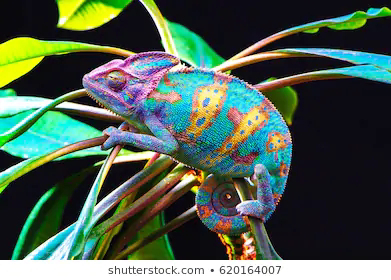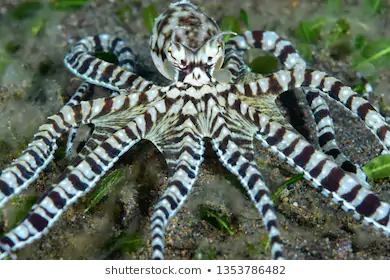In the animal world, there are predators everywhere. Without a bit of mother nature’s tinkering, a little critter and even a big fluffy animal does not stand a chance. An animal needs to have at least one defensive adaptation; it could be pointy spikes sprouting from their skin, it could be the ability to make a run for it when their predators come too close or it could be the ability to change the colouration of their body as quick as a flash.
Advertisements
An animal’s ability to change colour depends on environmental stimuli, light being the most often observed. These changes are controlled by the two communication and communication systems: the neuronal and endocrine systems.
Why do animals change anyway?
Animals change colour for many reasons. I will only mention three in this article but there are lots more.
1. To evade the attention of predators
Not all animals are as fast as the cheetah or as tough as the honey badger. Some animals are really slow, like the chameleon for example. The chameleon cannot use lightening speed or brute strength to stand up to its predators. Instead, they would prefer to go unnoticed. In order to blend in with their surroundings, they occasionally need to change their colour.
2. To display aggression
Again, our very colourful friends, the chameleon shall be used as an example. Chameleons, like almost every other animal fight. They fight over mate, over territory and even over food.
In the animal world, colours speak louder than words. Well, animals can’t actually talk anyway. The colour of a certain animal can tell another animal that animal’s mood and countenance. Colours are used to communicate willingness to mate and aggression.
Chameleon are more likely to have a colour battle than to fight an actual battle. It is less energy consuming.
3. As a response to seasonal change
There are a lot more animals that can change colours than you think. It is just that animals like the chameleon are more famous than most of them. Apart from changing colour to avoid predators and to display aggression, animals can also change colours because of the season.
My favourite example for this phenomenon is the stoat. The stoat is an animal that is a cousin to the weasel. They understandably look alike. Stoats have white colours in the winter and then change their colour to the more commonly seen brown. During the winter, their white fur blends in the snow and the brown, as you guessed, blends in with the summer beauty.
Category of animals in terms of colour changes
ListAwe classifies animals that have the ability to change colours into three simple groups:
1. Slow changers
These animals take a really long time to change colour, usually over a period of months. They change colours as a response to the seasons. An example is the stoat.
2. Quick changers
An example is the Chameleon. This kind of animals can change colour in less than half a minute. That is a big difference from the first category which takes much longer.
3. Super quick changers
These class of animals are even more faster than the previous category when it comes to colour changes. It is often fuelled by adrenaline; the emergency hormone. An example is the Chameleon Sand tilefish. Sounds like the Chameleon has a copycat; only that the copycat is better than the original.
Let us now focus on what brought us all here. We present to you six animals that you probably didn’t know could change colours:
1. Chameleons
Chameleons are perhaps the most popular reptiles apart from alligators and crocodiles. They belong to a family that contains so many individuals; they are lizards.
Chameleons can change the colour of their body in order to blend in with their environment. They are not particularly fast like other agile lizards (take the agama lizard for example) so they don’t stand a chance if they are spotted. However, you can’t chase what you don’t see. The chameleons use this to their advantage.
How do Chameleons change their body colour?
The chameleon actually uses a simple technique to change colours. They simply adjust a layer of specialized cells underlying their skin. These cells can cause the wavelength of light to change.
Chameleons are really cute creatures. They make lovely pets especially because they don’t run away. They are also really good at playing hide and seek. They do the hiding, you do the seeking.
2. Mimic Octopus
Octopuses are cute animals. They, unlike us, have eight arms. That is six more than we do. In addition to these, they have suckers on the arms so if you get caught by an hungry man-eating octopus, you are more likely to die than live.
Octopuses can change colours too. In fact, most octopuses can but none does it better than the mimic Octopus. This creature is named so because of its habit of mimicking almost anything. They can mimic corals, they can mimic cuttlefishes, they can even mimic a guitar player (just kidding). They do all this mimicry to avoid hungry predators. Yes, octopuses have predators too.
Mimic octopuses, like Chameleons can change colours. They do so in less than half a minute too.
3. Pacific Tree frog
Tree frogs are frogs too. They are just different because they prefer to spend their time among trees. They can attach theirselves to leaves thanks to their light weight streamlined body.
The Pacific Tree frog, a type of tree frog which lives in most parts of the North American continent can change colours too. Within 1-2 minutes, a Pacific Tree frog can change its body colour. They change colours in response to temperatures and seasons. Its predators which are an awfully long list are normally avoided by the frog’s impressive camouflaging ability.
4. Sea horses
Sea horses are not horses, they are actually fishes. You are surprised? I wish you could see my face when I found out too. Sea horses are also slow, horses are fast. Again, we notice a big difference.
Concerning colour changes, sea horses can colour because of special organelles called Chromatophores. These Chromatophores change their properties thereby affecting the colouration of the animal. Chromatophores are also found in Chameleons.
Sea horses can change their colour so that they can be more appealing to potential mates and so that they can “disappear” from predators. The latter process is more rapid than the former.
5. Cuttlefish
Like Octopuses who are their cousins, Cuttlefishes can change colour. They do this in order to observe prey without being seen and also in order to avoid predators.
The ability of a cuttlefish to change colour is due to two process; the presence of chromatophores and the presence of papillae in their skin. The papillae’s can be altered to change the roughness or smoothness of the cuttlefish’s skin. The whole process is controlled and coordinated by the nervous system of the cephalopod.
6. Squid
The mimic octopus and the cuttlefish are not the only cephalopods that made our list. The squid is another animal that comes from that family. All cephalopods have something weird about them. The octopus has eight arms, the cuttlefish has weird eyes and the squid has three hearts. Their blood is also not red like other normal animals. They do not possess haemoglobin which causes the blood of animals to appear red. Their blue blood is thick and therefore difficult to move without the presence of more than one heart.
In order to avoid predators, squids would change their skin colour. This, like virtually every other animal on this list, is thanks to the presence of chromatophores in their skin. If only we humans had chromatophores too. Then we could change colours as we like.
There you have it. That’s our list. I hope you enjoyed reading it.
Thanks for reading.
Image credit: Shutterstock
Please share.



















